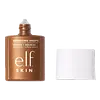What's inside
What's inside
 Key Ingredients
Key Ingredients

 Benefits
Benefits

 Concerns
Concerns

 Ingredients Side-by-side
Ingredients Side-by-side

Water
Skin ConditioningTrimethyl Pentaphenyl Trisiloxane
EmollientHydrogenated Polyisobutene
EmollientHelianthus Annuus Seed Oil
EmollientGlycerin
HumectantSynthetic Fluorphlogopite
Glyceryl Stearate Citrate
EmollientMica
Cosmetic ColorantBis-Behenyl/Isostearyl/Phytosteryl Dimer Dilinoleyl Dimer Dilinoleate
EmollientTocopherol
AntioxidantPhenoxyethanol
PreservativeSorbitan Isostearate
EmulsifyingHydroxyethyl Acrylate/Sodium Acryloyldimethyl Taurate Copolymer
Emulsion StabilisingCarbomer
Emulsion StabilisingCaprylyl Glycol
EmollientEthylhexylglycerin
Skin ConditioningTromethamine
BufferingDisodium EDTA
Polysorbate 60
EmulsifyingXanthan Gum
EmulsifyingSodium Citrate
BufferingSclerocarya Birrea Seed Oil
HumectantRubus Idaeus Seed Oil
EmollientC12-15 Alkyl Benzoate
AntimicrobialTin Oxide
AbrasiveTocopheryl Acetate
AntioxidantUbiquinone
AntioxidantCI 77491
Cosmetic ColorantCI 77499
Cosmetic ColorantCI 77492
Cosmetic ColorantCI 77891
Cosmetic ColorantWater, Trimethyl Pentaphenyl Trisiloxane, Hydrogenated Polyisobutene, Helianthus Annuus Seed Oil, Glycerin, Synthetic Fluorphlogopite, Glyceryl Stearate Citrate, Mica, Bis-Behenyl/Isostearyl/Phytosteryl Dimer Dilinoleyl Dimer Dilinoleate, Tocopherol, Phenoxyethanol, Sorbitan Isostearate, Hydroxyethyl Acrylate/Sodium Acryloyldimethyl Taurate Copolymer, Carbomer, Caprylyl Glycol, Ethylhexylglycerin, Tromethamine, Disodium EDTA, Polysorbate 60, Xanthan Gum, Sodium Citrate, Sclerocarya Birrea Seed Oil, Rubus Idaeus Seed Oil, C12-15 Alkyl Benzoate, Tin Oxide, Tocopheryl Acetate, Ubiquinone, CI 77491, CI 77499, CI 77492, CI 77891
Water
Skin ConditioningEthylhexyl Palmitate
EmollientGlycerin
HumectantIsododecane
EmollientDiethylhexyl Carbonate
EmollientIsohexadecane
EmollientPolyglyceryl-4 Diisostearate/Polyhydroxystearate/Sebacate
EmulsifyingPolymethylsilsesquioxane
Trimethylsiloxysilicate
EmollientSodium Chloride
MaskingC13-15 Alkane
SolventSodium Hyaluronate
HumectantSqualane
EmollientNiacinamide
SmoothingCentella Asiatica Leaf Extract
Skin ConditioningTocopheryl Acetate
AntioxidantTocopherol
AntioxidantPersea Gratissima Oil
Skin ConditioningCamellia Sinensis Leaf Extract
AntimicrobialCarthamus Tinctorius Seed Oil
MaskingGlycine Soja Oil
EmollientEthylhexylglycerin
Skin ConditioningHydrogenated Vegetable Oil
EmollientSilica
AbrasiveAlumina
AbrasiveDisteardimonium Hectorite
StabilisingMagnesium Oxide
AbsorbentPropylene Carbonate
SolventZinc Stearate
Cosmetic ColorantBoron Nitride
AbsorbentSodium Benzoate
MaskingPotassium Sorbate
PreservativeCaprylyl Glycol
EmollientPhenoxyethanol
PreservativeTitanium Dioxide
Cosmetic ColorantIron Oxides
Water, Ethylhexyl Palmitate, Glycerin, Isododecane, Diethylhexyl Carbonate, Isohexadecane, Polyglyceryl-4 Diisostearate/Polyhydroxystearate/Sebacate, Polymethylsilsesquioxane, Trimethylsiloxysilicate, Sodium Chloride, C13-15 Alkane, Sodium Hyaluronate, Squalane, Niacinamide, Centella Asiatica Leaf Extract, Tocopheryl Acetate, Tocopherol, Persea Gratissima Oil, Camellia Sinensis Leaf Extract, Carthamus Tinctorius Seed Oil, Glycine Soja Oil, Ethylhexylglycerin, Hydrogenated Vegetable Oil, Silica, Alumina, Disteardimonium Hectorite, Magnesium Oxide, Propylene Carbonate, Zinc Stearate, Boron Nitride, Sodium Benzoate, Potassium Sorbate, Caprylyl Glycol, Phenoxyethanol, Titanium Dioxide, Iron Oxides
 Reviews
Reviews

Ingredients Explained
These ingredients are found in both products.
Ingredients higher up in an ingredient list are typically present in a larger amount.
Caprylyl Glycol is a humectant and emollient, meaning it attracts and preserves moisture.
It is a common ingredient in many products, especially those designed to hydrate skin. The primary benefits are retaining moisture, skin softening, and promoting a healthy skin barrier.
Though Caprylyl Glycol is an alcohol derived from fatty acids, it is not the kind that can dry out skin.
This ingredient is also used as a preservative to extend the life of products. It has slight antimicrobial properties.
Learn more about Caprylyl GlycolEthylhexylglycerin (we can't pronounce this either) is commonly used as a preservative and skin softener. It is derived from glyceryl.
You might see Ethylhexylglycerin often paired with other preservatives such as phenoxyethanol. Ethylhexylglycerin has been found to increase the effectiveness of these other preservatives.
Glycerin is already naturally found in your skin. It helps moisturize and protect your skin.
A study from 2016 found glycerin to be more effective as a humectant than AHAs and hyaluronic acid.
As a humectant, it helps the skin stay hydrated by pulling moisture to your skin. The low molecular weight of glycerin allows it to pull moisture into the deeper layers of your skin.
Hydrated skin improves your skin barrier; Your skin barrier helps protect against irritants and bacteria.
Glycerin has also been found to have antimicrobial and antiviral properties. Due to these properties, glycerin is often used in wound and burn treatments.
In cosmetics, glycerin is usually derived from plants such as soybean or palm. However, it can also be sourced from animals, such as tallow or animal fat.
This ingredient is organic, colorless, odorless, and non-toxic.
Glycerin is the name for this ingredient in American English. British English uses Glycerol/Glycerine.
Learn more about GlycerinPhenoxyethanol is a preservative that has germicide, antimicrobial, and aromatic properties. Studies show that phenoxyethanol can prevent microbial growth. By itself, it has a scent that is similar to that of a rose.
It's often used in formulations along with Caprylyl Glycol to preserve the shelf life of products.
Tocopherol (also known as Vitamin E) is a common antioxidant used to help protect the skin from free-radicals and strengthen the skin barrier. It's also fat soluble - this means our skin is great at absorbing it.
Vitamin E also helps keep your natural skin lipids healthy. Your lipid skin barrier naturally consists of lipids, ceramides, and fatty acids. Vitamin E offers extra protection for your skin’s lipid barrier, keeping your skin healthy and nourished.
Another benefit is a bit of UV protection. Vitamin E helps reduce the damage caused by UVB rays. (It should not replace your sunscreen). Combining it with Vitamin C can decrease sunburned cells and hyperpigmentation after UV exposure.
You might have noticed Vitamin E + C often paired together. This is because it is great at stabilizing Vitamin C. Using the two together helps increase the effectiveness of both ingredients.
There are often claims that Vitamin E can reduce/prevent scarring, but these claims haven't been confirmed by scientific research.
Learn more about TocopherolTocopheryl Acetate is AKA Vitamin E. It is an antioxidant and protects your skin from free radicals. Free radicals damage the skin by breaking down collagen.
One study found using Tocopheryl Acetate with Vitamin C decreased the number of sunburned cells.
Tocopheryl Acetate is commonly found in both skincare and dietary supplements.
Learn more about Tocopheryl AcetateWater. It's the most common cosmetic ingredient of all. You'll usually see it at the top of ingredient lists, meaning that it makes up the largest part of the product.
So why is it so popular? Water most often acts as a solvent - this means that it helps dissolve other ingredients into the formulation.
You'll also recognize water as that liquid we all need to stay alive. If you see this, drink a glass of water. Stay hydrated!
Learn more about Water